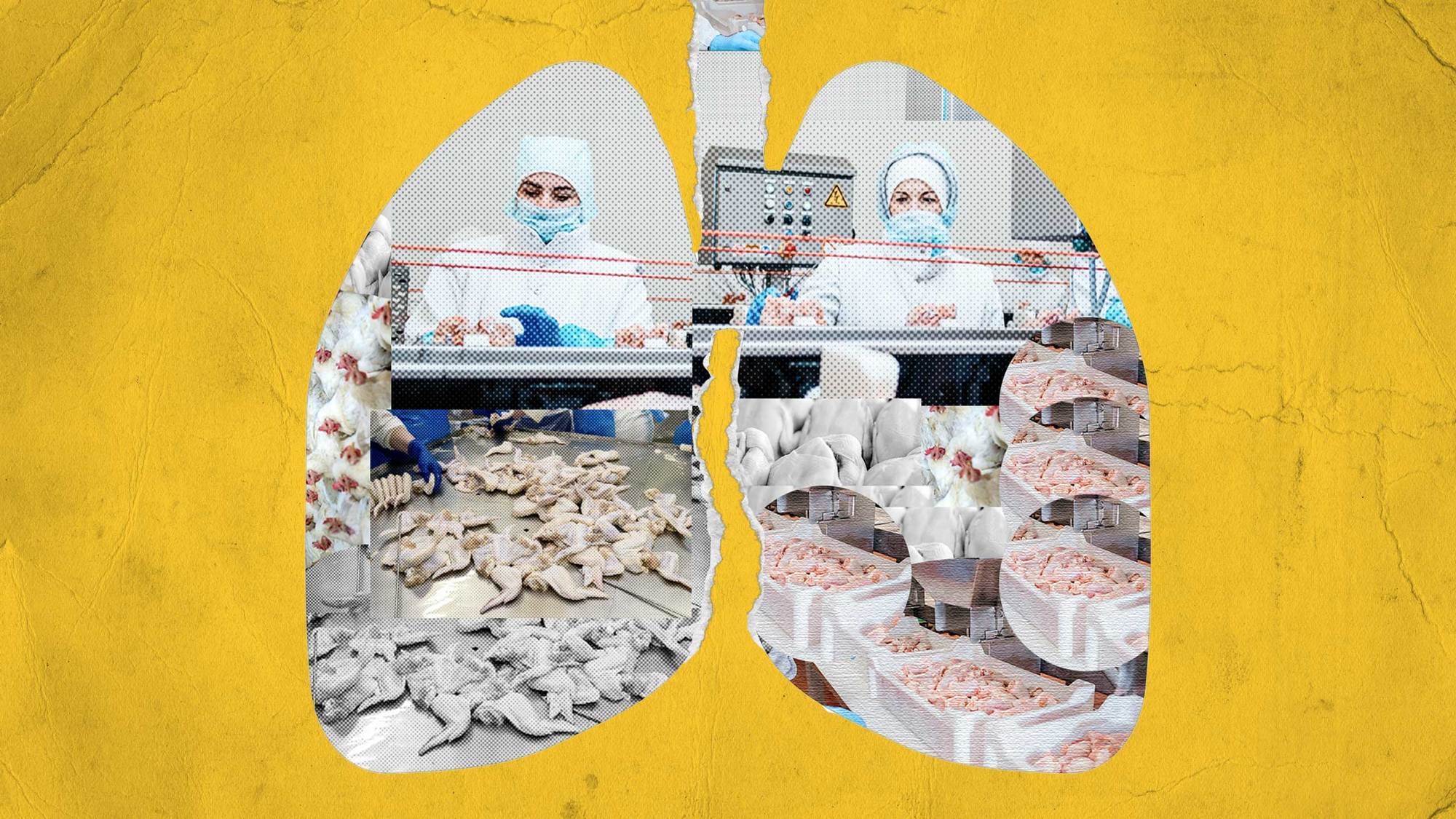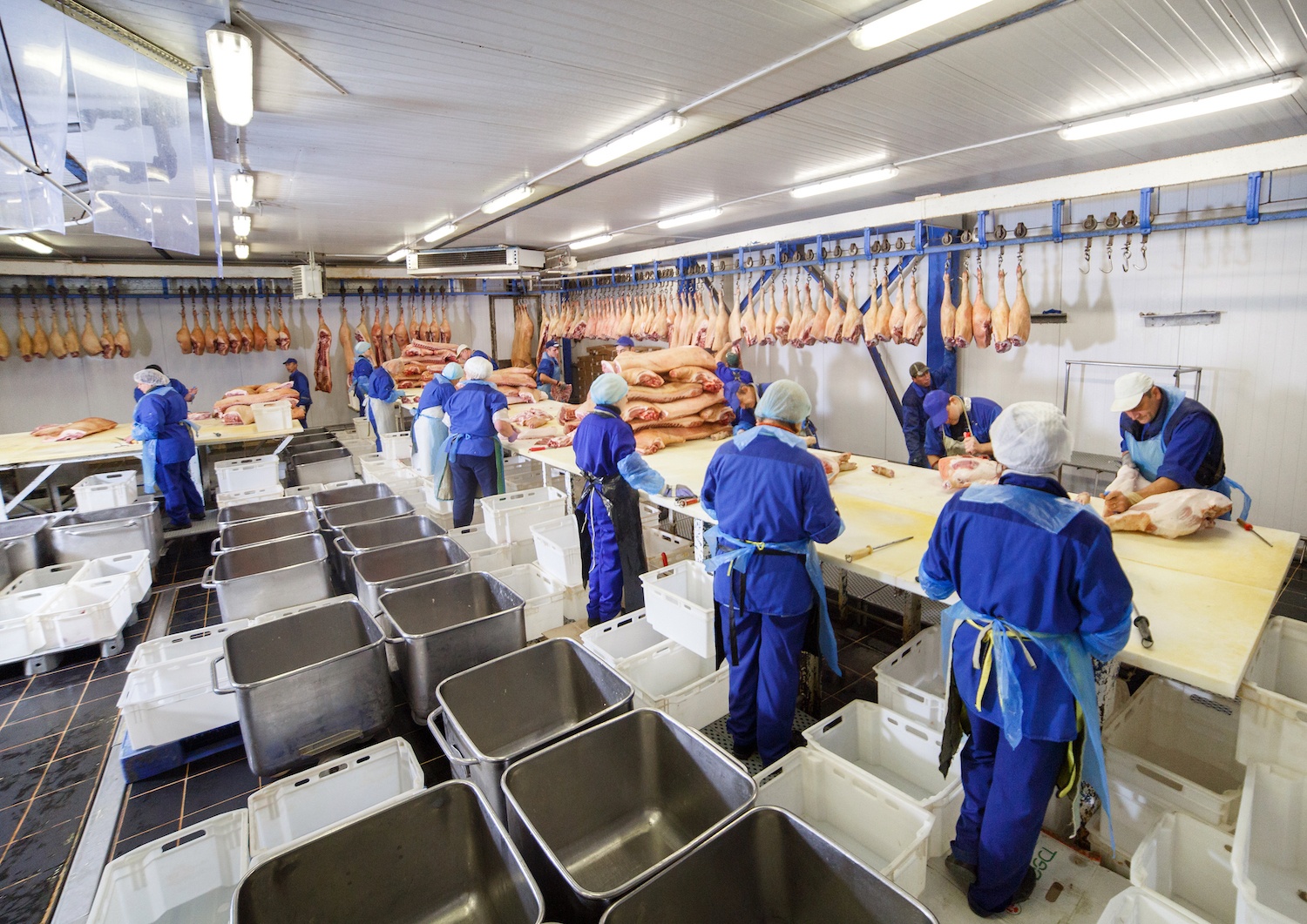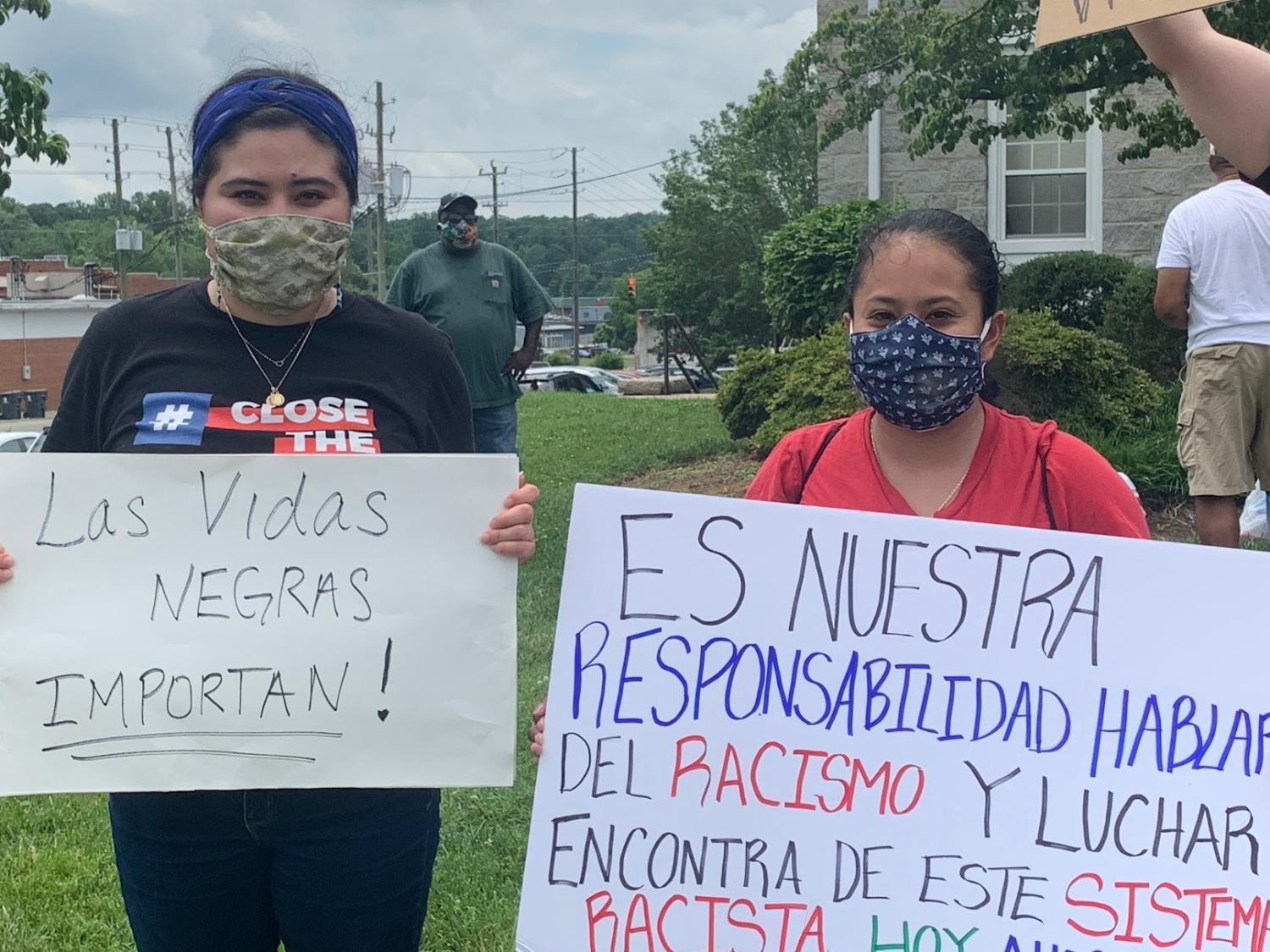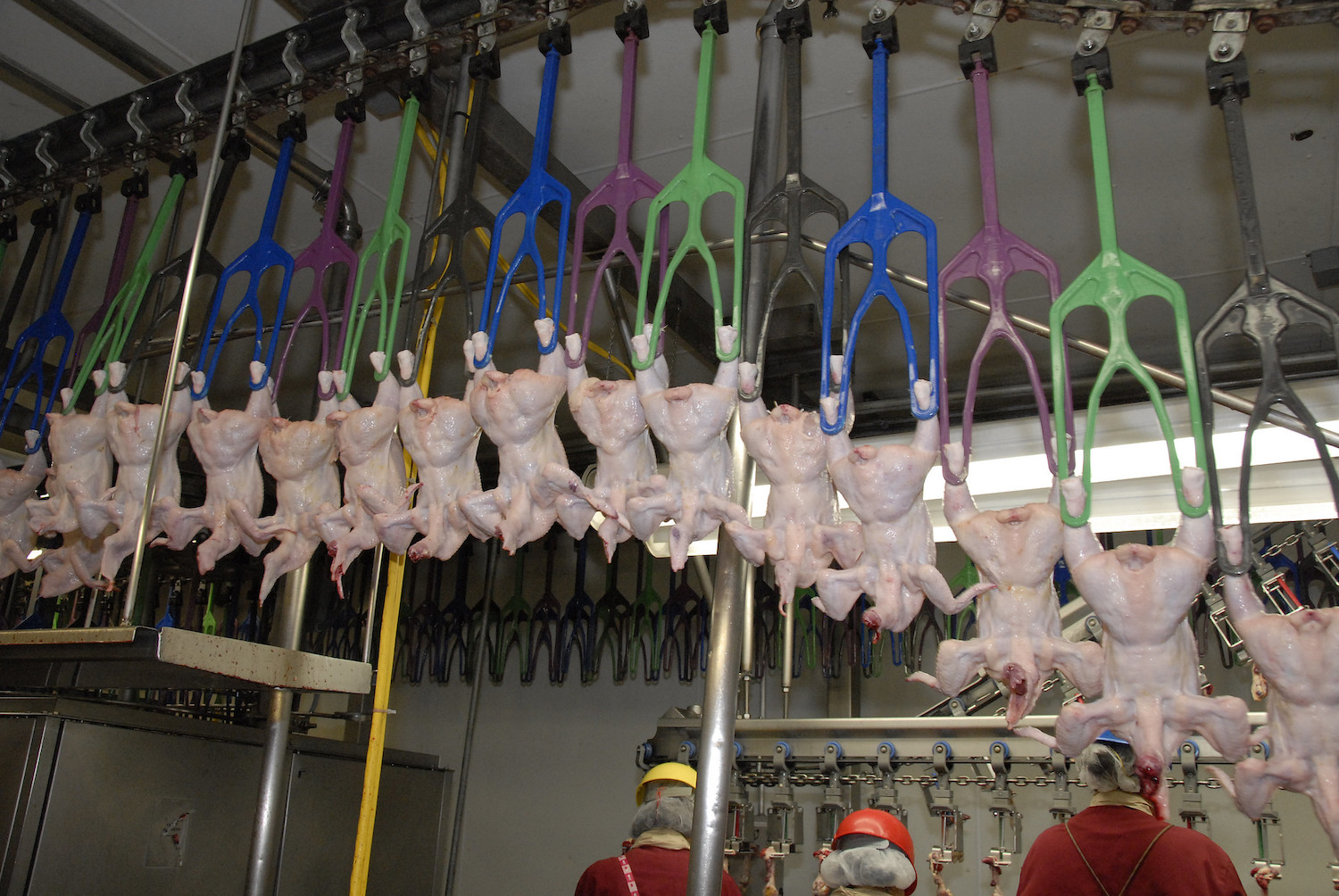
Graphic by Alex Hinton | Source Images: iStock
The poultry giant was fined $21,000 related to its use of peracetic acid, vindicating workers and their advocates—but will it fix anything?
After refuting workers’ claims that they were being exposed to a toxic chemical that gave them serious respiratory issues, poultry company Mountaire Farms was fined last week by the North Carolina Department of Labor (NC DOL). According to the agency, the company failed to provide employees with effective information and training regarding the use of a corrosive chemical that can cause severe skin burns, eye damage, and respiratory irritation. This is the second time in three years that the company has been cited for a similar violation.
In October, The Counter reported* that workers began to notice chemical fumes at Mountaire’s Lumber Bridge, North Carolina, poultry plant sometime during the summer. They described the smell as a “sharp, suffocating kind of odor” that felt like it “invaded your brain.” It stung their eyes and throats and burned their nasal cavity; they said the chemical also caused sneezing, headaches, dizziness, and mucus discharge. One worker said it caused her throat to feel like it was “cracking.” According to an attorney with the North Carolina Justice Center who interviewed Mountaire employees about the chemical, “dozens” of workers told her they reported symptoms to the nurse at the Lumber Bridge plant. But there was one problem: Mountaire would not tell its workers or the media the chemical that was causing illness, or even acknowledge workers’ health concerns were real.
On February 22, the Occupational Safety and Health (OSH) division of the NC DOL finally gave workers some answers. The agency fined Mountaire $21,000 for two alleged violations related to the use of Spectrum 22, a chemical that contains peracetic acid. Though commonly used in plants to reduce the risk of foodborne pathogens like salmonella and campylobacter, federal regulators have set no safety standards for the chemical’s workplace usage. Tyson and Perdue have also made headlines for violations and accidents related to peracetic acid.
Mountaire’s first citation, an alleged “repeat serious” violation carrying a $14,000 fine, is related to the company’s failure to train workers on the hazards associated with Spectrum 22 or how to protect themselves against exposure. (Mountaire was cited for a similar violation at the Lumber Bridge plant in 2019.) The second alleged violation, also characterized as serious, is related to Mountaire’s failure to provide and require the use of eye protection for workers handling chicken parts that had been sprayed with or or dipped in tanks containing Spectrum 22.

The Occupational Safety and Health (OSH) division of the NC DOL fined Mountaire Farms Inc. $21,000 for two alleged violations related to the use of Spectrum 22, a chemical that contains peracetic acid.
Graphic by Tricia Vuong | Source Images: North Carolina Department of Labor and iStock/Andriu_s
“Mountaire plans to contest these citations, because they are incorrect,” the company’s spokesperson, Catherine Bassett, wrote in a statement to The Counter. “We offer extensive training to all of our employees on a variety of topics, including chemical safety. Our safety teams are very involved in ensuring that our workforce is safe and using all Personal Protective Equipment (PPE) that is standard in our industry.”
According to NC DOL’s notice, the violations must be fixed and the company must pay the fines within 15 days, unless Mountaire appeals. As one former NC DOL employee told The Counter, repeat violations are rare and not good for companies’ reputations, which means companies often “vigorously fight” repeat citations.
Hazardous chemical
Workers and advocates in the state have lingering concerns about employees’ safety at the plant, and the citations issued to Mountaire lead to more questions than answers. Notably, OSH makes no mention of the levels of Spectrum 22 being used at the plant. NC DOL said that because this is still an open case, the agency is unable to share additional, specific information about the inspection until the case is closed. Ideally, the final inspection file will provide more information regarding Mountaire’s practices concerning peracetic acid.
Back in 2013, Stan Painter, a former inspector with the Department of Agriculture (USDA), predicted that poultry plants would “increase their reliance on chemicals to make up for inspection gaps”—and this included a reliance on peracetic acid. Painter described the process that commonly makes workers sick: Poultry carcasses sprayed with peracetic acid are put in the chiller and depending on the chlorine concentration of the chiller, “it can be like having a bucket of bleach under your nose,” he explained.
Because of Mountaire’s silence on the issue, workers assumed the chemical was ammonia or bleach due to its strong and noxious odor. This is why ammonia is referenced in the complaint filed by the North Carolina Justice Center on behalf of a Mountaire worker.
“I told the supervisor, ‘I need to go home. I feel very sick. I’m going to throw up.’ He wouldn’t let me leave. Nobody cared.”
“The original complaints were about ammonia and bleach. The latest findings have nothing to do with ammonia or bleach. As for Spectrum 22 or peracetic acid, this is a chemical that is commonly used inside hospitals, health care facilities, and food manufacturing facilities,” Mountaire’s spokesperson said in an email.
While USDA permits the use of peracetic acid up to a certain level on food products, the Occupational Safety and Health Administration (OSHA) confirmed to The Counter that it currently has “no permissible exposure limit for peracetic acid” in the workplace. OSHA does maintain standards that apply to other chemical use in poultry processing plants, including those associated with safety management of highly hazardous chemicals, personal protective equipment, and hazard communication.
These kinds of citations related to peracetic acid now appear to be fairly common.
If peracetic acid isn’t mixed properly or it’s used at very high levels, it can become noxious. Yet OSHA isn’t issuing citations directly related to workers’ respiratory issues; the citations are often issued because an employer failed to properly train workers on the chemical’s potential hazards. It’s unclear how long Spectrum 22 has been used at the Lumber Bridge plant or whether Mountaire uses peracetic acid as part of daily operations. Obtaining records related to peracetic acid can be challenging, given the hodgepodge of state and federal plans. Mountaire has operations in five states, none of which are overseen by federal OSHA. Some have an OSHA-approved state plan that covers all workplaces, while others have an OSHA-approved state plan that covers state and local government workers only. But despite the challenges in obtaining company-wide data, Lumber Bridge clearly isn’t an isolated operation: In 2018, about 318 gallons of peracetic acid spilled onto the ground at Mountaire Farms’ Selbyville, Delaware, plant, leading to citations, according to records.
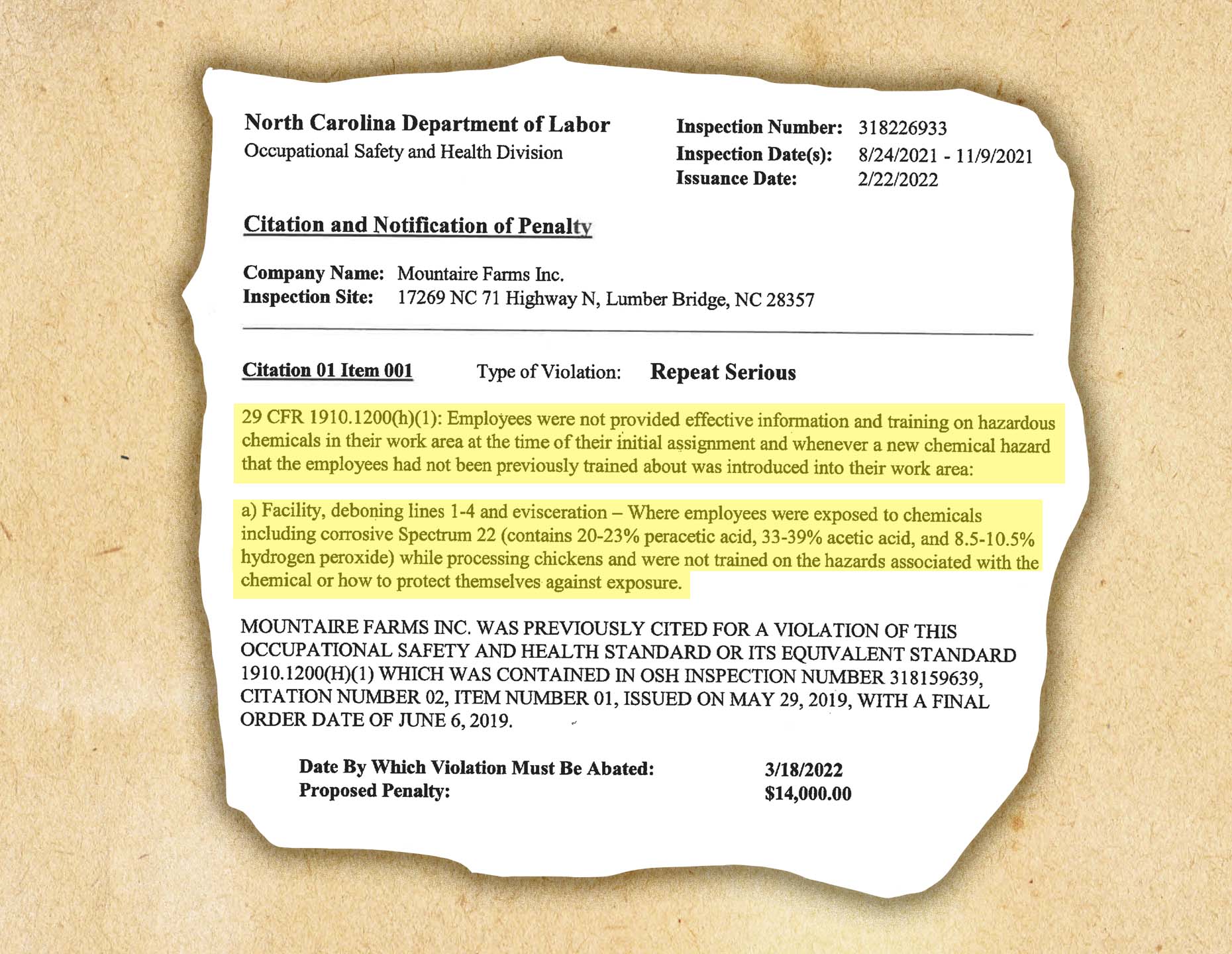
An excerpt highlighting the specific citation from the Occupational Safety and Health (OSH) division of the NC DOL against Mountaire regarding lack of employee trainings and information about chemical exposures.
Graphic by Tricia Vuong | Source Images: North Carolina Department of Labor and iStock/Andriu_s
NC DOL said in its citations that Spectrum 22 was used on the plant’s deboning lines 1-4 and in the evisceration department, but one former worker using the pseudonym Rosa said employees on many other lines were also “exposed” and experienced respiratory issues. Rosa said she left Mountaire a few months ago to recover from an unrelated health issue that she says her doctor feared was exacerbated by the plant’s chemical use, but she still has family members who work for Mountaire.
Prior to the pandemic, there appeared to be some movement toward addressing peracetic acid safety issues. In California, for example, regulators were working on rules regarding airborne concentrations for the chemical. In 2019, OSHA entered into an alliance with the U.S. Poultry & Egg Association, the National Chicken Council, and the National Turkey Federation, with a goal of providing training and education around the safe handling and use of peracetic acid. The Counter reached out to these agencies to learn where these efforts are now.
A spokesperson for the California Department of Industrial Relations said that while a Health Effects Advisory Committee performed a review of peracetic acid and issued recommendations
for concentrations of the chemical in December 2017, peracetic acid has “yet to move to rulemaking.” A spokesperson for OSHA did not comment on whether the federal agency is considering a permissible exposure limit for peracetic acid, but said that the alliance with poultry trade groups led to the development and implementation of “a worker safety culture perception survey” and to scripts “for employee micro-learning videos on peracetic acid exposure.”
Long-term health concerns
Dr. Howard Hu, a specialist in occupational and environmental medicine at the University of Southern California’s Keck School of Medicine, reviewed the safety data sheet for Spectrum 22. As an expert on the impact of toxic chemical exposure to human health, Hu said Spectrum 22 sounds like “a product that was designed for a workplace that doesn’t exist.”
“The product says how it’s supposed to be used, but obviously most poultry plants don’t have conditions that align with how the product is intended to be used,” Hu said. “Someone who was exposed to this product without the benefit of either the appropriate ventilation or respiratory protection will be at increased risk for a lung infection, just like the case that was cited in the complaint.”
Hu is referring to the August 19 complaint that triggered the inspection that led to Mountaire’s recent citations. Carol Brooke, the senior attorney at the North Carolina Justice Center (which filed the complaint), included reference to a Lumber Bridge poultry plant worker who was hospitalized for a lung infection in July 2021. A family member of the worker previously confirmed the information with The Counter, alleging that the illness and hospitalization were both the result of exposure to what—at the time—was an unknown chemical.
“Someone who was exposed to this product without the benefit of either the appropriate ventilation or respiratory protection will be at increased risk for a lung infection.”
Evonik Active Oxygens, LLC, manufacturer of the chemical, recommends that Spectrum 22 only be used outdoors or in well-ventilated areas. However, windowless and crowded poultry plants–facilities where Covid-19 spread like wildfire–are typically not known for being open and airy. (A spokesperson from NC DOL said that the lack of windows in a plant “does not necessarily suggest that a facility is not well-ventilated.”) Previously, Rosa said that only some areas of the poultry lines were outfitted with small air vents.
Brooke said it was “immediately obvious” when she spoke to Mountaire workers that they were experiencing respiratory issues.
“The workers that I talked to were coughing on the phone and had hoarse voices,” Brooke said.
According to the Mountaire workers Brooke remains in communication with, the chemical is still in use at the plant. This information was echoed by Ilana Dubester, founder and executive director of nonprofit advocacy organization El Vínculo Hispano. Last summer, Dubester’s organization interviewed several workers about their symptoms with the goal of helping them file a complaint; they still maintain regular contact with Mountaire workers.

Dr. Howard Hu, a specialist in occupational and environmental medicine at USC’s Keck School of Medicine explains that repeated overexposure of the chemical can cause the lungs to develop a sensitivity to respiratory irritants leading to an asthmatic-type reaction.
Graphic by Talia Moore | Source Images: iStock
Rosa says her family members and friends still employed at the Lumber Bridge plant continue to report the presence of a sour-smelling chemical that leaves them struggling with dizziness, headaches, and coughs. While she’s desperately in need of the paycheck, Rosa said she is also relieved not to currently be working for Mountaire. She often thinks about an experience she had late last year before she had to go on medical leave. Rosa said she was deboning chicken on the line when she began to feel very sick.
“I told the supervisor, ‘I need to go home. I feel very sick. I’m going to throw up.’ He wouldn’t let me leave,” she said. “Nobody cared. Mountaire didn’t care. I told my supervisor, ‘We’re not animals. You can’t treat us like animals. We’re human beings.’” Rosa left the line to vomit in the restroom. When she returned to her job, she alleges that three supervisors were waiting to reprimand her.
Rosa said her son also quit working for Mountaire Farms shortly after she stopped working at the Lumber Bridge plant. “He was tired of feeling sick,” she said.
Mountaire told The Counter that it prioritizes workers’ safety and that the Lumber Bridge plant “recently celebrated a record 10 million hours without a lost time accident and remains one of the safest processing plants in the country by all objective measurements.”
There is a great deal of evidence to suggest the company relies heavily on an immigrant workforce–and many of the workers who went public about the company’s chemical use were migrants.
Brooke said it can be hard to make sense of the fact that chemicals like peracetic acid are approved—they’re safe for the food product but not necessarily safe for the workers. This is why the attorney said it’s so important for Mountaire–and the staffing companies it contracts with–to properly train workers on how to deal with chemical hazards in their already-dangerous workplace.
The workers in North Carolina’s poultry plants are overwhelmingly Latino. While the specific demographics of Mountaire’s two plants in the state are unknown, there is a great deal of evidence to suggest the company relies heavily on an immigrant workforce–and many of the workers who went public about the company’s chemical use were migrants. In 2012, a study found that Latino workers in North Carolina’s poultry industry experience decreased lung function due to exposure to bacteria, cleaning agents, and dust on the job. Hu said that based on what he’s read about Mounaire workers’ symptoms, he’s worried that long-term exposure to Spectrum 22 and chemicals like it can cause a condition called Reactive Airways Dysfunction Syndrome (RADS), a variant of asthma.
“At some point–either from repeated overexposures or sometimes from a single massive overexposure–the lungs can develop a sensitivity to respiratory irritants and respond with an asthmatic-type reaction, which includes symptoms like wheezing and shortness of breath. It wouldn’t surprise me if there are workers who develop shortness of breath related to repeated exposures to this chemical, but they just didn’t make the connection because for example, they got short of breath walking into a perfume store or when they were standing next to a truck giving off a lot of exhaust,” Hu said. “They might not know they’ve developed a chronic health problem.”
‘The truth about Lumber Bridge’
Workers and advocates in the state say they feel conflicted about the fines NC DOL issued to Mountaire. Brooke said the penalties are “absurdly low.” According to NC DOL, the maximum penalty for each willful or repeat serious violation is $70,000.
“This is a repeat citation, and it could have carried a much higher penalty,” the attorney said. “And it’s certainly not high enough to make any difference to a poultry company that makes millions or billions of dollars each year. Peracetic acid is a chemical that is now routinely used in poultry plants, so Mountaire certainly knew the dangers of the chemical. I can’t imagine that their failure to train workers properly and use the chemical in a way that exposed workers to health problems wasn’t wilful.”
Rosa believes that each worker made sick by exposure to the chemical should be given $21,000, the total amount NC DOL fined Mountaire. Even with the absence of financial compensation for workers, however, Rosa expressed that she feels vindicated. While Mountaire characterized workers’ concerns as “bogus complaints” filed by “advocacy organizations,” there is now evidence from the government that workers weren’t lying. Rosa said she feels “very proud” of herself and the other immigrant workers who went public to expose conditions in the plant.
“I hope this sets an example for other plants–not just in the state, but in the whole country,” Rosa said.
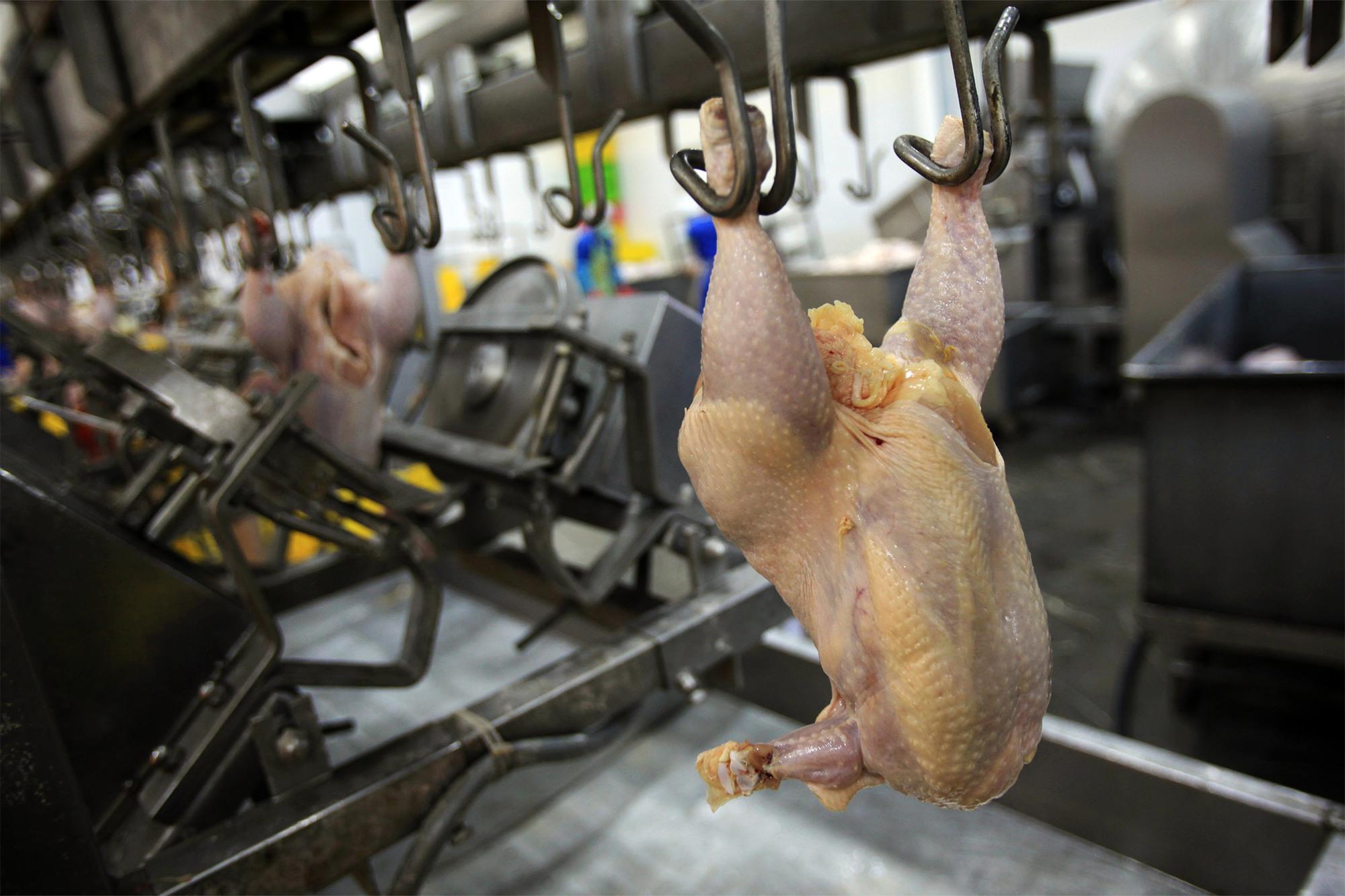
Dr. Howard Hu said he “highly recommends” that employees at the plant request a Health Hazard Evaluation (HHE) from the National Institute for Occupational Safety and Health (NIOSH), a federal research institute responsible for making recommendations for the prevention of work-related injuries and illnesses.
Mansoreh Motamedi/Getty Images
Coming forward wasn’t easy. While she reiterated she doesn’t currently work inside the plant, Rosa said that workers are fearful that Mountaire is “angry” about the publicity, and rumors are circulating that the company is eager to terminate those who spoke to the media.
Mountaire has publicly refuted workers’ allegations and lashed out at reporting on the subject. On October 20, just two days after The Counter published its reporting about chemical exposure at the Lumber Bridge plant, Mountaire posted “The Truth about Lumber Bridge” on its blog. In it, the company alleged that it investigated the allegations internally and found they had “no merit.” Mountaire also claimed that OSH “did not suggest any changes to any operations in Lumber Bridge” when it inspected the plant in August. “While we await their final report, the fact that they didn’t take any immediate action suggests they saw nothing out of the ordinary,” the blog read.
NC DOL spokesperson Jennifer Haigwood would not comment on the claims in Mountaire’s blog post, but she clarified that the agency’s OSH inspection was still open and ongoing in October when the company published its post. “The citations speak for themselves,” Haigwood wrote.
A majority of the post’s focus sought to discredit reporting related to the workers’ health concerns. References to reporting included quotes around the word “news,” indicating published reports were fake.
“These ‘news’ stories are filled with anonymous sources, rumor and speculation, and are completely without merit,” the post read. “When advocacy publications pose as legitimate news sources and print unsubstantiated allegations and rumors, it not only destroys credible journalism, it affects innocent people who no longer know how to separate fact from fiction.”
At the time of our original coverage, Bassett failed to respond to five requests for comment from The Counter–including a bulleted list of allegations pulled directly from the reporting prior to publication. Still, the company claimed otherwise. On November 8, a Rose Law Firm attorney representing Mountaire contacted The Counter and alleged we did not take steps to verify the allegations we printed.
Mountaire’s attorney claimed The Counter’s reporting on chemical exposure at the Lumber Bridge plant was “false, libelous, and potentially damaging to its business.”
Mountaire’s attorney claimed The Counter’s reporting on chemical exposure at the Lumber Bridge plant was “false, libelous, and potentially damaging to its business.”
“We previously asked The Counter to substantiate its false claims and for four months they have not done so,” Bassett said in a February 25 email after the company was fined by NC DOL for serious violations. “We place worker safety as our primary goal and we call on the Counter to stop hiding behind anonymous sources and send us facts and information so that we can investigate.”
Dubester said Mountaire’s response is “a very bad look” for the company.
“It doesn’t make any sense to mount a [public relations] campaign against workers and reporters. According to Mountaire, everyone is lying–reporters are lying, workers are lying, advocates are lying, everyone is lying,” Dubester said. “It’s actually very offensive. With my own ears, I’ve heard workers cough so hard they couldn’t breathe. What would they get out of making false allegations?”
Workers and advocates are anxiously awaiting Mountaire’s response to the penalties imposed by NC DOL, but in the meantime Hu said it’s important to remember that there is still nothing stopping Mountaire from using Spectrum 22 at levels that make workers feel sick. The doctor said he “highly recommends” that employees at the plant request a Health Hazard Evaluation (HHE) from the National Institute for Occupational Safety and Health (NIOSH), a federal research institute responsible for making recommendations for the prevention of work-related injuries and illnesses.
An HHE is an evaluation of a workplace to determine whether workers are exposed to hazardous materials, and whether these exposures are responsible for health risks, illness or injury, or harmful conditions. Based on their findings, NIOSH investigators recommend ways to reduce hazards and prevent work-related illnesses and injuries. Per standard HHE Program procedures, OSHA and state health and labor agencies would receive a copy of the final report that provides findings and recommendations. Federal law also prohibits employers from retaliating or punishing employees for making HHE requests or cooperating with the HHE program.
Rosa, who worked at the Lumber Bridge plant for five years, is currently weighing her options. Jobs in rural North Carolina are hard to come by for migrant workers, but it’s unlikely she’d return to Mountaire.
“Even if they would have me back, I don’t think I can go back,” Rosa said. “Hopefully, I can find something else to do that is safer.”
*NOTE: The initial headline for that story stated that workers were quitting in large numbers, an accusation in the worker complaint that could not be wholly verified.

